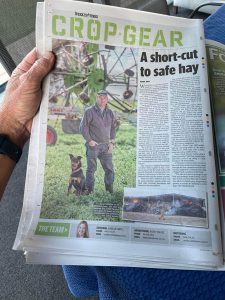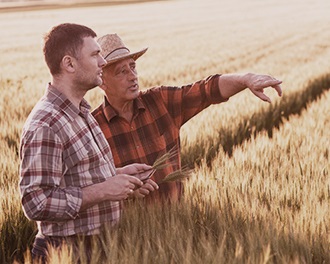A short-cut to safe hay
2023
WIMMERA hay producer David Manifold is using an innovative technique to speed up haymaking while improving quality and reducing the… Read more
WIMMERA hay producer David Manifold is using an innovative technique to speed up haymaking while improving quality and reducing the risk of haystack fires.
The accelerated drying method allows baling to be completed within seven days of cutting, compared to the normal two to three weeks in the conventional method, by using an additive called Hay Guard.
David and Edwina Manifold grow about 1600ha of crops and run 1100 Highlander ewes at Gil Gil, northeast of Donald.
Crops include morava vetch and mulgara and yallara oats cut for hay, including for export.
Normally if hay is baled too early the moisture content may be too high leading to the growth of yeasts and moulds, which create heat and gases that lead to spontaneous combustion and disastrous stack fires, Mr Manifold said.
“I was unlucky enough to lose 4000 tonne in a shed fire once and I’m not keen for it to happen again,” Mr Manifold said.
“The conventional method of making hay means is it sits on the ground for two to three weeks after it’s cut so it can dry out to the correct moisture content, then we bale it at night to bring the moisture level back up a bit.
“But with the accelerated method we cut it on day one, ted it the next day and then maybe again the following day, rake it back together and then bale it with the Hay Guard, during the daytime, around day seven.
“We can achieve our target of 14-16 per cent moisture in the bale and keep it there.”
Hay Guard is a sulphur-based preservative. When applied to hay, it reduces or prevents the yeast and mould growth that leads to heating and combustion. It also preserves the hay’s nutritional value and dry matter content. There are other additives that can be used including organic acids and their salts, bacterial inoculants and ammonia-based additives.
Hay Guard allows hay to be baled at moisture levels of up to 25 per cent, about a third higher than conventionally made hay, meaning hay can be harvested much earlier in the season and for much longer each day.
Hay Guard turns into gas inside the bale and searches for oxygen then “eats” it, prohibiting microbial growth. “If you are doing 2000-3000 acres (800-1200ha) of hay that’s quite a few extra passes so there is a time limit on how much you can actually get done that way, but we do as much as we can,” Mr Manifold said.
“We can make our export oaten hay within seven days just using a conditioner and bale at 14 per cent moisture, but we still use the Hay Guard as it helps reduce the variability in moisture content and sort of stabilises it at or below 14 per cent,” Mr Manifold said.
In an on-farm trial they found a big increase in yield and feed quality of vetch hay made with the accelerated method. It was worth about $540 a hectare more than the hay baled two weeks later, due to rain damaging the later-baled hay while on the ground. Because he has to cover a lot of hectares every day for several weeks with the advanced drying technique, Mr Manifold needs high capacity forage harvesting equipment.
He uses a Claas Volto 1300 tedder with an operating width of 13m and a Claas Liner 2900 rake with a maximum operating width of 9m.
Dried windrows are baled using a Claas Quadrant 5300 big square baler and then picked up using a Claas Scorpion 736 telehandler.
A Gazeeka moisture meter monitors dew and stem moisture as forage passes through the bale chamber and the Hay Guard is applied at 1.2 litres/tonne using a Palmer tank mounted on the baler.
“The idea is to get an average 16 per cent sap moisture when baling and we also closely monitor the bale temperature
after it is baled using temperature probes, to ensure no heating is occurring,”Mr Manifold said.





